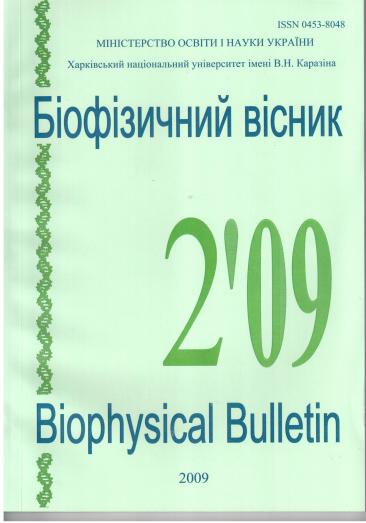Spectroscopic study of pheophorbide-a methyl ether binding to synthetic polynucleotides and DNA
Abstract
Binding of pheophorbide-a methyl ether (Mepheo-a) to synthetic double-stranded poly(A)poly(U),
poly(G)poly(C) polynucleotides, four-stranded poly(G), and native DNA was studied by methods of
absorption and polarized fluorescent spectroscopy. Measurements were carried out in aqueous buffered
solutions pH6.9 of low ionic strength (2 мM Na+) in a wide range of phosphate-to-dye molar ratios (P/D).
Absorption and fluorescent characteristics of complexes formed by the dye with the biopolymers were
determined. It is established that binding of neutral Mepheo-a to four-stranded poly(G) is accompanied by
significant spectral transformations, namely, by dye absorption hypochromic, the bathochromic shift of Soret
absorption band (~26 nm), the bathochromic shift of fluorescence band maximum (~9 nm) and 50-fold increase of dye fluorescence intensity. Unlike that, Mepheo-a binding to double-stranded poly(A)poly(U),
poly(G)poly(C) polynucleotides, and to calf thymus DNA is accompanied by insignificant spectral shifts of
absorption and fluorescence bands, as well as by no more than 4-fold rise of fluorescence intensity. Observed
substantial spectral changes and high value of fluorescence polarization degree (0.26) evidence the intercalation of dye chromophore to four-stranded polynucleotide structure. An insignificant increase of dye fluorescence polarization degree (0.12) and weaker spectral transformations point to another binding mode, namely, incorporation of MePheo-а to a groove of the double helix, presumably, in the dimeric form. Since binding of MeРheo-a to four-stranded poly(G) polynucleotide induces substantial changes in fluorescent characteristics of the dye, this derivative is promising as a fluorescent probe for monitoring the G-quadruplex structure.
Downloads
References
Owens J.W., Smith R., Robinson R. and Robins M. // Inorg. Chim. Acta.– 1998.– v. 279.– p. 226–231.
Dougherty T.Jr., Gomer C.J., Henderson B.W., et al. // J. Natl. Cancer Inst.– 1998.– v. 90.– p. 889– 905.
Ricchelli F. // J. Photochem. Photobiol. B: Biol. – 1995.– v. 29.– p. 109–111.
Willstatter R. and Stoll A. Untersuchungen über Chlorophyll. Methoden und Ergebnisse. – Berlin: Springer, 1913.
Röder B. // J. Photochem. Photobiol. B: Biol. – 1990. – v.5. – p. 519-521.
Röder B. // Lasers Med. Sci.– 1990.– v.5.– p.99-106.
Roeder B. Pheophorbides. – Photodynamic Tumor Therapy: 2nd and 3rd Generation Photosensitizers. (J.G. Moser, Ed.) .– Amsterdam: Harwood Academic Publishers. – 1998.– p. 35-42.
Hajri A., Wack S. et al. // Photochem. Photobiol.– 2002.– v.75.– p.140-148.
MacDonald I.J. and Dougherty T.Jr. // J. Porphyrins Phthalocyanines.– 2001.- v. 5.– p.105-129.
Krasnovsky A. Jr. et al. // J. Photochem Photobiol. B: Biol.– 1990.– v.5.– p. 245-254.
Roeder B. Photobiophysical parameters. – Photodynamic Tumor Therapy: 2nd and 3rd Generation Photosensitizers. (J.G. Moser, Ed.). – Amsterdam: Harwood Academic Publishers. – 1998.– p. 9-19.
Tanielian C., Kobayashi M., Wolf C. // J. Biomed. Opt. – 2001. – v. 6. – p. 252-256.
Eichwurzel I., Stiel H., Roeder B. // J. Photochem. Photobiol. B.: Biol. – 2000.– v.54.– p.194-200.
Kobayashi M., Koyama S., Nakazato M., Miyoshi N., Wolf C., Daikuzono N., Tanielian C., Sasaki M., Komiyama M. // J. Clin. Laser. Med. Surg.– 1994.–v.12. – p. 133-138.
Ryazanova O.A., Voloshin I.M., Dubey I.Ya., Dubey L.V., Zozulya V.N. // Annals of the New York Academy of Sciences.– 2008.– v.1130.– p. 293-299.
Ryazanova O.A., Voloshin I.M., Dubey I.Ya., Dubey L.V. and Zozulya V.N. // IFMBE Proceedings.– 2008.- v.20.- p. 397-400.
Wongsinkongman P., Brossi A., Wang H.-K., Bastow K.F., Lee K.-H. // Bioorganic & Medicinal Chemistry.– 2002.– v.10.– p.583-591.
Zozulya V., Blagoi Yu., Lober G., Voloshin I. et al. // Biophys. Chem. –1997-v.65, p. 55-63.
Lakowicz, J.R. 1999. Principles of Fluorescent Spectroscopy 2nd ed. Kluwer Academic/Plenum Press. New York.
Spikes, J.D. & Bommer, J.C. 1991. Chlorophyll and related pigments as photosensitizers in biology and medicine. In Chlorophylls. H. Scheer, Ed.: 1181-1204. CRC Press, Boca Raton, Florida, USA.
Rabinowitch E. // Rewiew of modern physics.–1944.– v. 16(3-4).– p. 226-235.
Röder, B. // J. Photochem. Photobiol, B: Biol.– 1987.– v.1.– p.103-113.
Mansouri S., Fery-Forgues S., Meunier B., Paillous N. // J. Chem. Soc. Perkin Trans. 2 .– 1996.– v.8.– p. 1649-1654.
Mergny J., Phan A., Lacroix L. // FEBS Letters.– 1998.– v.435.- p.74-78.
Löber G., Kittler L. // Studia biophysica.–1978.– v.73(1).– p.25-30.
Seidel C., Schulz A., and Sauer M. // J. Phys. Chem.- 1996.- v.100.– p.5541-555.
Taima H., Yoshioka N., Inoue H. // Org. Biomol. Chem. – 2009.–v. 7.– p. 1176-1183.
Authors who publish with this journal agree to the following terms:
- Authors retain copyright and grant the journal right of first publication with the work simultaneously licensed under a Creative Commons Attribution License that allows others to share the work with an acknowledgement of the work's authorship and initial publication in this journal.
- Authors are able to enter into separate, additional contractual arrangements for the non-exclusive distribution of the journal's published version of the work (e.g., post it to an institutional repository or publish it in a book), with an acknowledgement of its initial publication in this journal.
- Authors are permitted and encouraged to post their work online (e.g., in institutional repositories or on their website) prior to and during the submission process, as it can lead to productive exchanges, as well as earlier and greater citation of published work (See The Effect of Open Access).





